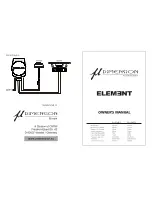
3
Home Theater 6.1 & 7.1 Suggested Placement
S
TEP
5:
S
ELECT
S
URROUND
C
HANNEL
S
PEAKER LOCATIONS
Choosing a location for the surround speakers requires
some ingenuity and creativity to balance room aesthetics
with function. Try to place these speakers to the left and
right of your listening position (at least 3 feet away) and
aiming directly at each other. We also recommend a
vertical height of 2 to 3 feet above your listening position.
Distance between these speakers should be the same or
greater than the distance between the front left and right
speakers. Do not be concerned with any reflections;
these will only enhance the desired ambient sound
characteristics of the surround channels. Please see the
placement diagrams for 5.1, 6.1, and 7.1 recommended
surround placement. Please note, if you intend to place
the surrounds behind the listening position against the
rear wall and aiming towards the front of the room, be
sure your listening position is at least 3 feet away from the
rear speakers.
S
TEP
6:
S
URROUND
S
PEAKER ORIENTATION
For “HTM-200 SE” series speakers, orient the left/right
surround speakers vertically with the tweeter closer to the rear wall. If the speakers are behind the
listening position, orient vertically with the tweeters to the outside. In typical 6.1 and 7.1 systems, it is
common to use our CMT series center channel lying horizontal several feet behind and above the
listening position.
CONNECTION TO AMP OR RECEIVER
Once the initial speaker locations are chosen and your audio
system is TURNED OFF, you may connect each speaker to its
appropriate output channel on the back of your amplifier or receiver.
Ascend Acoustics recommends the use of quality 14 gauge or
larger diameter copper stranded speaker wire. All of our
loudspeakers are equipped with high quality gold plated 5-way
binding posts that allow for an easy and secure connection with the
majority of cables and terminations available. We don’t believe any
particular kind of speaker wire termination is better than any other,
however, the use of banana plugs does allow the ability to quickly remove and reconnect the wires.
Be careful to connect the (+) and (–) amp/receiver outputs to their respective (+) and (–) input terminals
on the back of each speaker. Red refers to plus or positive, while black refers to minus or negative.
Once all appropriate connections have been achieved, you may power the system and enjoy. In order
to receive maximum performance, it is critical to wire the speakers “In-Phase”, meaning ALL speakers
in your audio system have been wired positive to positive and negative to negative.
Bi-Wiring
Several of our loudspeakers offer the ability to be bi-wired. If your speakers have 2-pairs of inputs on
the back (as opposed to 1-pair) and one set is labeled “High-Frequency” while the other is labeled
“Low-Frequency”, your speakers have the option to be bi-wired. Bi-wiring offers the ability to send the
high frequency signals and low frequency signals distinctly to the high frequency and low frequency
section of the speaker’s internal crossover. This is accomplished by running 2-pairs of cables off of one
set of amp or receiver outputs directly to the respective input on the crossover. The theory is that by
separating these frequencies, certain intermodulation distortions can be minimized, thus improving the
overall performance of the speaker.
Содержание HTM-200 SE
Страница 1: ......


























